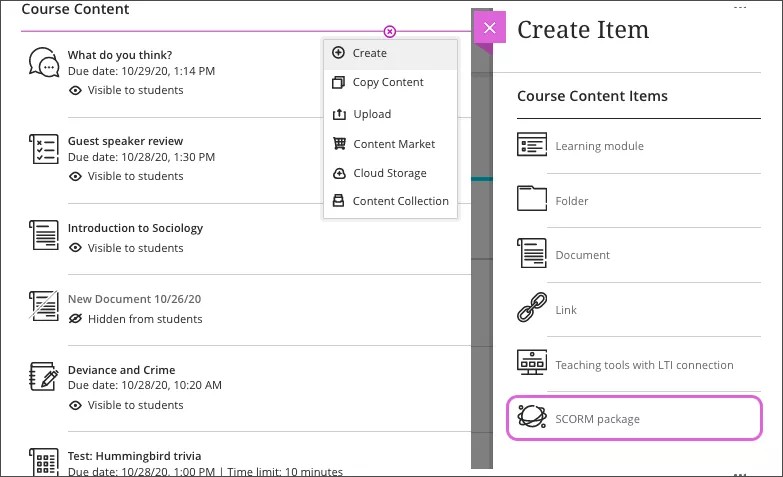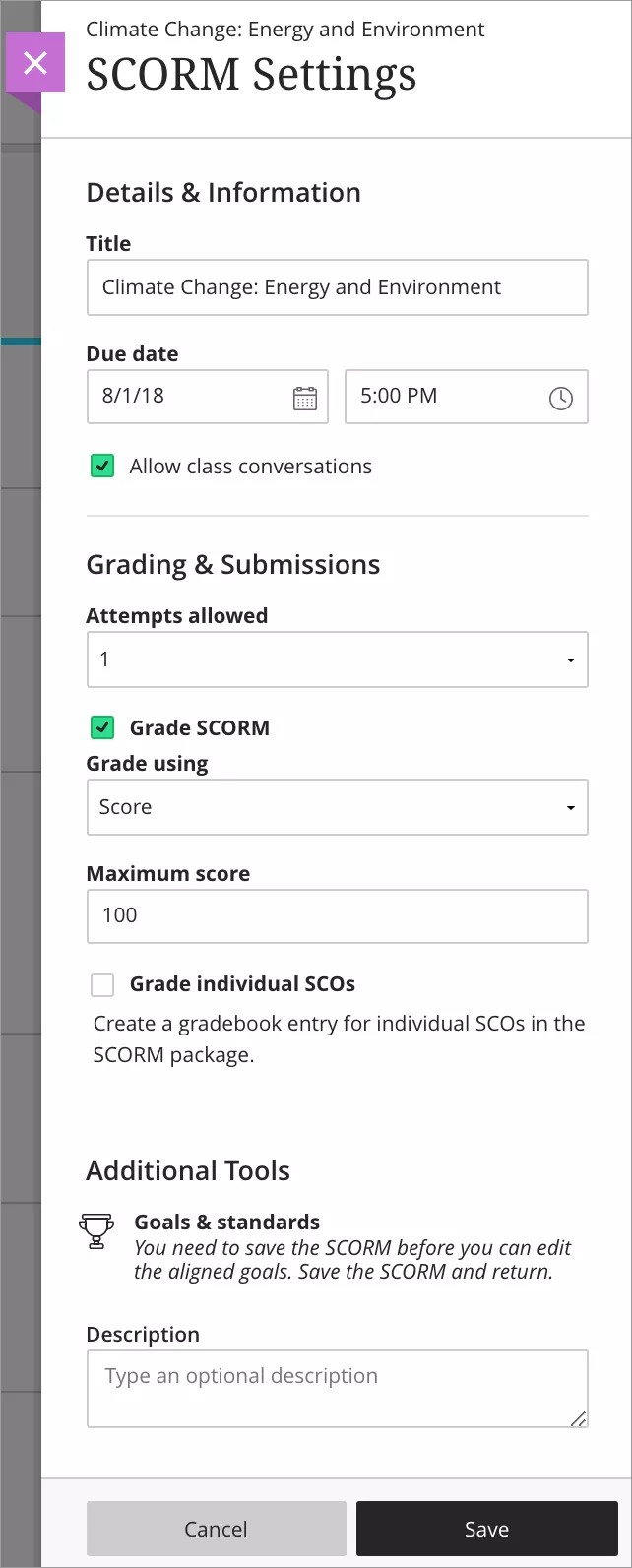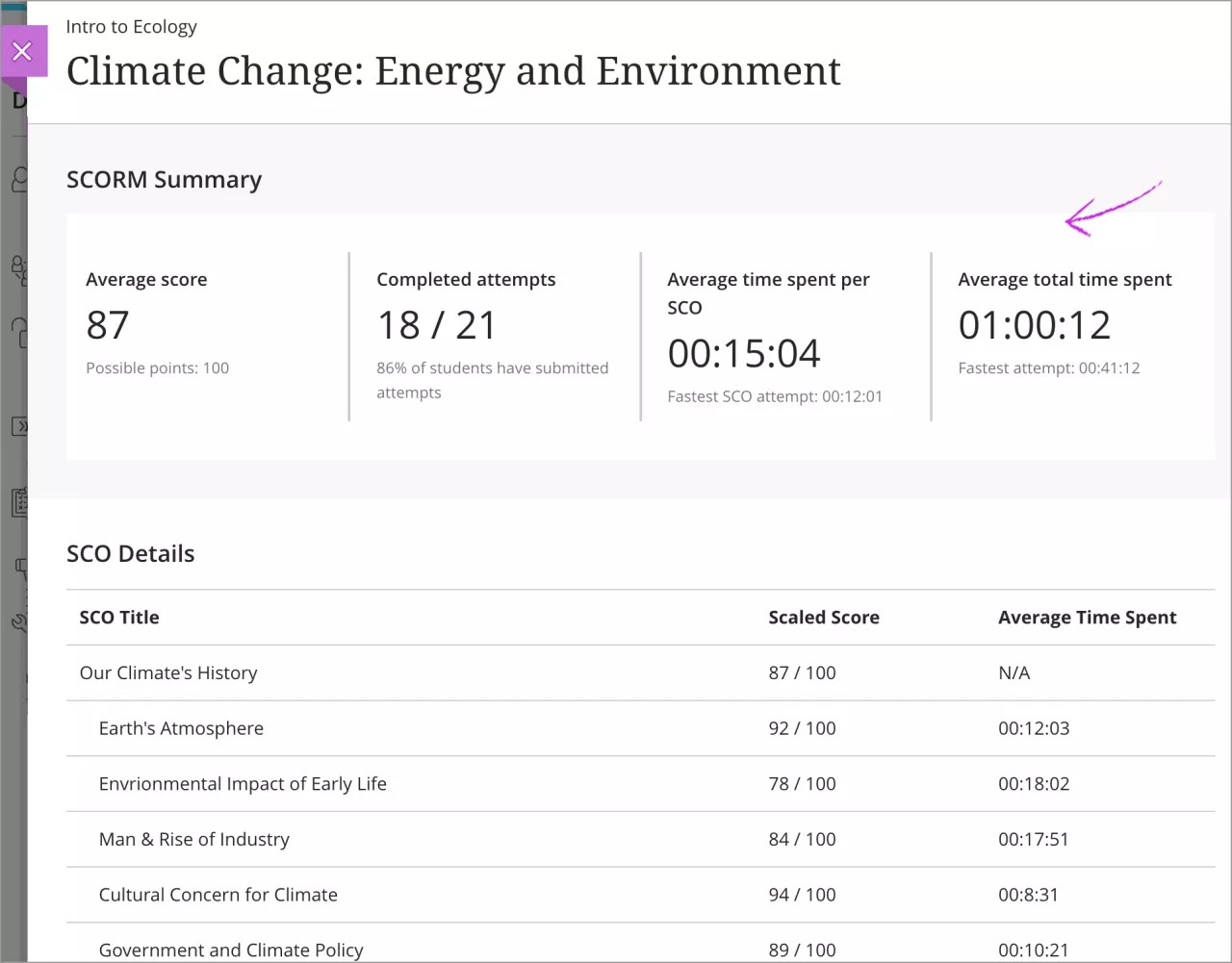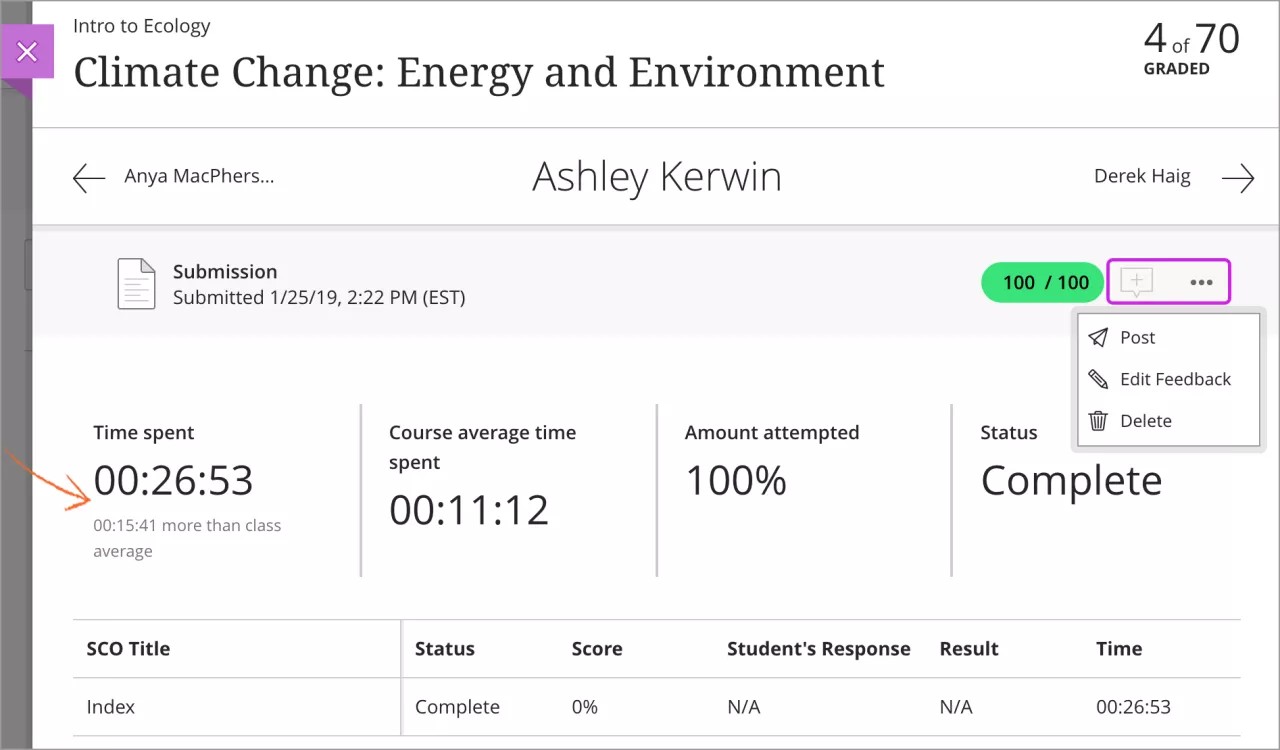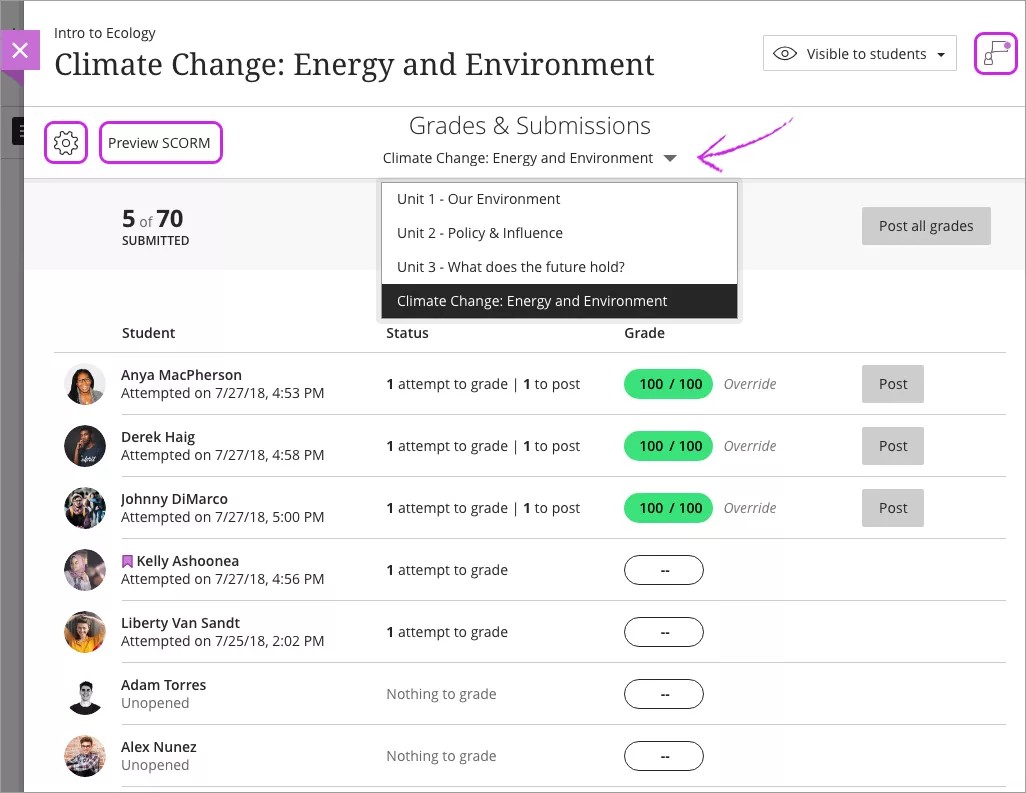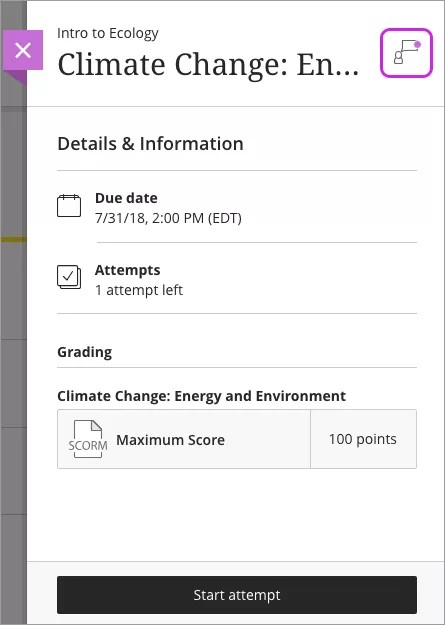This information applies only to the Ultra Course View.
Add SCORM content packages to your course
One type of web-based learning content you can use in your course is called an SCO, or Shareable Content Object. These SCOs are gathered together into a compressed ZIP file called a content package. The zipped file can be unpackaged and played through a content player. Typically, individual components or entire packages are provided to you by schools, publishers, commercial companies, or other sources.
Your institution controls whether the SCORM Engine is enabled. If enabled by your institution, the SCORM Engine B2 becomes the default content player for all newly uploaded content packages, as well as any existing content package that are re-uploaded.
SCORM content
The SCORM Engine supports content that conforms to the SCORM 1.2 standard, the SCORM 2004 standard, as well as AICC and the playing of xAPI packages. Blackboard Learn currently doesn't include a xAPI Learning Record Store (LRS) however basic data passed will be viewable in the gradebook.
You don't need to determine ahead of time what the content type is, as the add content option uses the same process for all supported types. For example, in the case of uploading IMS content packages, a message may appear saying Some issues were found with this course which may affect playability and a sub message that the package isn't in SCORM format and it will assume it's an IMS Content package.
Add a SCORM content package
Add a SCORM package to your course the same as any other piece of content.
- On the Course Content page, select the plus to add content.
- In the menu, select Create to open the Create Item panel. Select SCORM package.
- In the SCORM Settings panel, select Upload SCORM package or Browse Content Collection.
- Locate and select the SCORM package to upload.
After the file has been uploaded and checked, the SCORM Settings panel appears where you can set the content package details.
- In the Details & Information area, type a Title and select a Due date. You can also allow class conversations for students to have quick exchanges about the SCORM package.
In the Grading & Submissions area, select the Grade category and number of Attempts allowed. By default, a graded SCORM with multiple attempts uses Last attempt with a grade to determine the final grade. You can't change this setting.
- Select Grade SCORM to add a gradebook entry for the package. Select the grading schema and maximum score. You can't change the grade settings after you import the SCORM.
Select Grade individuals SCOs to add a gradebook entry for selected parts of the SCORM package. When you select this option, the list of SCOs within the package appears. For each SCO you select, you can also select the grading schema and maximum score.
Hover on a SCO in the list to reveal the Edit icon, represented by a pencil. Select the icon to rename the SCO.
- When you grade individual SCOs, the Reveal grade option appears. You can reveal the grade to students after SCORM completion.
- Optionally, type a Description.
- Select Save to finish the import.
After you import the SCORM package, you can changes its visibility, align goals, and edit other settings. You won't be able to change grading options after you import the SCORM package.
Delete a SCORM package
You can delete a SCORM package from your course and if no student submissions exist, the gradebook item is also deleted. For SCORMs with submissions, you must confirm that you want to permanently remove the SCORM, all submissions, and grades from your course.
Or, hide the SCORM from students to preserve the submissions and the scores in the gradebook. Students can't access hidden content on the Course Content page or on their grades pages even if you've graded submissions.
In the Original Course View, you can delete a SCORM package without removing submissions and grades. The column remains in the gradebook. If the course is converted to Ultra, the column appears as an offline item in the Ultra gradebook.
SCORM settings
You can edit SCORM settings from the Course Content page and the gradebook. Open the menu and select Edit to open the settings. From the Grades & Submissions page, select the gear icon.
Show or hide the SCORM package. Students can't see a SCORM package until you choose to show it. You can create all your content ahead of time and choose what you want students to see based on your schedule. You can also set availability conditions based on date, time, and performance on other items in the course gradebook. On the Course Content page, students can see when you set the SCORM to show.
Allow class conversations. What if your students have questions about a SCORM package? You can allow conversations within a SCORM package, and anyone can contribute. As the conversation develops, it appears only with the relevant content.
Change the grade category. You can change the SCORM's grade category to be part of one of the custom gradebook categories you set up in your course. You can create new categories to customize how coursework is grouped in your course. Custom categories can be useful when you set up the overall grade.
Determine the number of attempts. You can let your students submit more than one attempt at a SCORM.
By default, a graded SCORM with multiple attempts uses Last attempt with a grade to determine the final grade. You can't change this setting.
Add goals and standards. You can align a SCORM package to one or multiple goals. You and your institution can use goals to measure student achievement across programs and curriculums.
Add an optional description. The description appears with the SCORM title on the Course Content page.
You can't change the grade schema or maximum score after you import a SCORM package. To change the grade schema or maximum score, you'll need to delete the SCORM and reimport it.
SCORM analytics
Get insight into your SCORM package with analytics reports. You can view SCORM activity for the class as a whole or an individual student's progress. The reports contain key pieces of data that help put student performance in context.
Analytics reports aren't available for ungraded SCORM packages.
Course SCORM report
To view a course SCORM report:
- Go to the Course Content page.
- Open the menu for the SCORM package and select View Analytics.
- This report shows performance for the whole class.
The course-level SCORM report shows you how students perform on average. The averages in the report are calculated based on submitted attempts.
- Average score: Average score of all attempts on the SCORM. The SCORM's total possible points are also visible to help put the number in context.
- Completed attempts: The number of students who submitted an attempt compared to the total number of students. This number is also shown as a percentage.
- Average time spent per SCO: If the SCORM package contains multiple SCOs, this number shows the average time students spent on all SCOs.
- Average total time spent: Average amount of time students spent in the SCORM.
The table shows detailed data for each SCO in the SCORM package. View the SCO Title, Scaled Score, and Average Time Spent.
If the SCORM package contains no SCOs, the table contains one row and SCO Title appears as Index.
Student SCORM report
To view a student's SCORM report:
- Go to the Grades & Submissions page.
- Select a student's submission.
- You can find this page from the gradebook list view or when you preview the SCORM.
If you allow multiple attempts for the SCORM, an analytics report appears for each attempt. You can't see every attempt a student makes in one analytics report. Select an attempt to view this information:
- Time spent: Amount of time the student spent in the SCORM. Compare this number with Course average time spent to determine if the student completed the attempt quickly or spent more time than other students. This information is helpful to determine if a student struggled to complete the SCORM.
- Course average time spent: Average amount of time students spent in the SCORM. The average is calculated based on submitted attempts.
- Amount attempted: Student's progress in the SCORM, measured as a percentage. The value is 100% when the SCORM attempt is complete.
- Status: Student's attempt status.
The table shows detailed data for each SCO in the SCORM package. View the SCO Title, Status, Score, Student Response, Result, andTime.
- SCO Title: Title of the specific SCO contained in the SCORM.
- Status: Whether the student completed or didn't complete the SCO.
- Score: Student's score for a graded SCO.
- Student's Response: Student's response to the SCO.
- Result: Whether the student answered the SCO's questions correctly or incorrectly.
- Time: How long the student spent within the SCO.
If the SCORM package contains no SCOs, the table contains one row and SCO Title appears as Index.
You have access to all grading features when you view a student's SCORM report. Enter a grade, add feedback, post the grade, or delete the attempt.
Grades & Submissions page
Keep track of all submissions on one page. Quickly see which attempts are ready to grade. Student profile pictures appear with a red circle when they have late attempts or the due date has passed with no attempt submitted.
Preview the SCORM. Before you begin grading, you can review SCORM content. Select Preview SCORM to launch the package and browse through the content.
Toggle the Submission list. Quickly flip between graded items within the SCORM package. You can select individual SCOs from the list if you chose to grade them on SCORM import.
View students with accommodations. You can set accommodations for individual students and exempt them from requirements, such as assessment due dates. Use accommodations to help students progress in the course even though they may have difficulty with some requirements. Icons appear next to the names of students with accommodations.
Keep up with the conversation. If you allowed conversations about this content, select the Open class conversation icon. Students can discuss the content with you and their classmates. As the conversation develops, it appears only with the relevant item.
A purple circle appears with the icon to indicate new activity.
Grade SCORM attempts
When a student submits an attempt or completes a SCO or SCORM package, the activity appears in the gradebook. You can assign a grade on the Grades & Submissions page or in the gradebook grid. Select Post Grade when you're ready to release the grade to the student.
At this time, you can't view student attempts for SCORM or SCO content. We're developing additional SCORM grading support for future releases.
Ready to post grades? Post appears next to each grade that you haven't released yet. You can choose which grades to post and when. Posted grades appear with a Posted message in the column. You can also grade all submissions for an item in succession and then select Post all grades to release all grades in one action.
Student workflow
Students can open the SCORM package just like any other content on the Course Content page and on their global and course grades pages. When students access the SCORM, the Details & Information panel appears, where they can see the due date, number of attempts allowed, and any goals you've aligned. Students can also access the conversation from this panel.
The student selects Start attempt or Continue attempt if they've opened the SCORM previously and have unsubmitted work. A new window opens with the SCORM content.
When you assign a grade, students are notified in their activity streams and course and global grade pages.
Advanced Settings
Contact your institution for assistance and guidance if you feel the need to adjust the advanced settings.
SCORM player settings are set for maximum compatibility and performance. However, you can adjust the Advanced Settings to configure how the SCORM behaves if you prefer. The content package should have the intended navigation, flow, and behavior. The default settings should display it correctly and consistently.
The Navigational Controls and Launch Behavior are likely to be the most useful for instructors with a basic level of understanding of how SCORM content works. Debugger Options and History Options can help in troubleshooting.
To access the SCORM player Advanced Settings, you must edit an existing SCORM content package.
- Access a content area or folder where the SCORM content package has already been uploaded.
- Open the SCORM content package's menu and select Edit.
- Select Advanced Settings. These categories appear:
- Navigational Controls
- Launch Behavior
- Compatibility Settings
- Communication Settings
- Debugger Options
- History Options
- Select Save. If you don't want to commit any changes you've made, select Cancel.
Navigation controls
The Navigational Controls allow you to include buttons, bars, and other navigational elements student see and use when accessing the course content using the SCORM player.
| Setting | Function |
|---|---|
| Show navigation | Determine whether the SCORM player will display a navigation bar to the student. The navigation bar must be enabled for any of these settings to take effect:
|
| Show title bar | Determine whether the SCORM player displays a title bar to the student. The Show navigation setting must be enabled for this setting to take effect. |
| Prevent right click | Prevents a student from right-clicking in the SCORM player windows. If the right mouse button is clicked, nothing happens. This can be useful in high-stakes assessments or where you don't want the student to be able to see the internal structure or content in the player. This setting only affects the SCORM player windows, including the course structure and the navigation bar (if present), and doesn't affect any other content, browser windows, or computer desktop functions. |
| Show Course Structure | Determines if the SCORM player should display the course structure. If selected, the course structure displays to the left of the content, in an outline format. This can be useful for courses containing multiple content objects. This setting must be enabled for any of these settings to take effect:
|
Launch behavior
Launch Behavior settings control the initial appearance of the content when first launched by the student.
| Setting | Function |
|---|---|
| SCO launch type | These settings determine how each SCO will be launched:
|
| Player launch type | These settings determine how the SCORM player will be launched:
|
| New window options | These settings determine the dimensions of either the content player when launched in a new window. These settings have no effect unless a new window setting has been selected as SCO launch type or Player launch type.
|
| Prevent window resize | Determines whether to prevent the content player windows from being resized by the student. |
| Available offline | Determine if the SCORM package is available to download to the offline/mobile SCORM player. |
Compatibility settings
Although usually there's no need to change default settings, Compatibility Settings can help in troubleshooting course content packages that encounter errors, fail to launch, or have other problems.
As with all the advanced settings, but especially here, if you do feel there is a need to adjust the Compatibility Settings, you should first contact your institution for assistance and guidance.
You may need to change these settings if you encounter problems when you re-upload course content that previously used an older content player. This is especially true for older and possibly non-standard content. To help determine exactly where the problem lies, we recommend enabling the detailed Debugger Options and reviewing the resulting message logs.
| Setting | Function |
|---|---|
| Finish causes immediate commit | This setting is provided to deal with single SCO courses where there is difficulty in capturing exit status. You may want to try enabling this setting if a single SCO course is failing to record completions accurately. |
| Wrap SCO window with API | When an SCO is launched in a new window, some non-standard or poorly coded content may not be able to find and communicate properly with the SCORM Engine. Enabling this setting puts a kind of wrapper-an API, or application program interface-around the player, and this API automatically knows how to talk to the SCORM Engine. |
| Always flow to first SCO | If enabled, the SCORM player always loads the first course in a SCO, regardless whether the sequencing rules dictate this behavior. |
| Mastery score overrides lesson status | When enabled, if the mastery score indicates the SCO is complete or not complete, this overrides whatever the actual lesson status may be. |
| Allow complete lesson status to change | Applicable to SCORM 1.2, this setting determines whether a lesson marked as complete can be changed at a later date to something other than complete. |
| Rollup empty set to unknown | For SCORM 2004 courses, this setting determines the rollup status when there are no activities providing information to set the status. If selected, both course completion and satisfaction status are set to unknown. |
| Disable root activity | Prevents a student from creating a new attempt by forcing the course navigation tree and any other links which could restart the course or an SCO within it to be disabled and not to respond to clicks. |
| Rollup at SCO unload | Forces score rollup when the SCO unloads, to handle those SCOs which fail to explicitly call for a rollup to be performed. |
| Override objective and completion set by content to true | The default for SCORM 2004 and the default for the SCORM 1.2 player can sometimes lead to an SCO being marked as completed and satisfied if the SCO fails to report the correct runtime status data. This setting overrides the default behavior for courses that don't set the appropriate default sequencing rules. |
| Make student preferences global to course | Causes any student preferences set in a given SCO to apply to all SCOs in a given SCORM Content Package course. |
| Launch completed registrations as no-credit | Determines whether completed course registrations are launched subsequently as normal or as no-credit. |
| Completion status of failed success status | Set an override value for the completion status of an SCO that a student has failed:
|
| Lookahead sequencer mode | Lookahead processing enables the SCORM Engine to dynamically update the course navigation structure that's visible and available depending on the state of the current SCO. By default, this setting should be enabled. For very large courses, this may cause noticeable slowing in web browsers and if deemed unacceptable, you can set this to disabled. Available settings are:
|
| Reset runtime data timing | Determines when the SCORM player will reset the CMI (computer managed instruction) data timing:
|
| Maximum suspend data size | |
| Internet explorer compatibility mode | Renders a X-UA-Compatible Meta Tag in the deliver frameset, apiwrapper frameset and intermediate page which can dictate the way content in child frames renders. |
Communication settings
Communication Settings determine how the Content Player interacts with the server. These settings may need to be adjusted if there are reported timeouts or communication failures between the students' computers and the server. The settings should only be changed by an administrator or experienced SCORM developer.
| Setting | Function |
|---|---|
| Maximum failed attempts | Sets the maximum number of attempts to attempt a runtime data update to the server before declaring failure. If this number is exceeded, an error message appears. |
| Commit frequency in milliseconds | Determines how often the runtime data is updated to the server. Some events, such as completing a course, force an update. |
Debugger options
Debugger Options determine whether and how much logging information is recorded within the various SCORM subsystems.
When encountering problems or errors with course content playback or presentation, enabling the Debugger Options so you, your administrator, or an expert SCORM support person can review the message logs is often an essential step in troubleshooting and resolving the issue. Using the History Options to record routine (non-error) status details can also provide useful information.
| Setting | Function |
|---|---|
| Debugger Options | Determines the level of logging to be performed within each of the associated SCORM subsystems: Control (overall system functions), Runtime (the launching and operation of SCOs), Sequencing (what happens outside of and between SCOs), or Look-ahead
|
| Include timestamps | Determines whether timestamps will be recorded with the events in the debugger log files. |
History options
History Options control whether and how much status information about the SCORM Content Package course content is logged. Error information isn't included in this log.
| Setting | Function |
|---|---|
| Capture history | Determines whether the Content Package should send back information about each attempt. |
| Capture detailed history | Determines whether the Content Package should send back detailed information about each attempt. |

